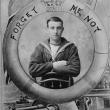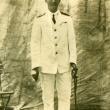Search our records : Gerald Thomas Restorick
| Surname: | Restorick |
| Forename(s): | Gerald Thomas |
| Date of Birth: | 4th September 1891 |
| Force: | Royal Naval Reserve |
| Civilian Occupation: | Boat builder |
| Parents: | Thomas and Mary Ella Restorick |
| Home address: | Beer, Devon |
Gerald Restorick was born in Beer on 4th September 1891[1]. His parents were Thomas Restorick, a carpenter and boat builder, and Mary Ella Restorick, both of whom were also born in Beer[2].
Gerald had two brothers, Algernon, who was five years older than him, and John, who was five years younger. In the 1911 census both Algernon and Gerald were described as carpenters in the building trade, while John was an apprentice carpenter. Gerald also had two younger sisters, Dulcie and Anna. In 1911 Dulcie was a dressmaker, while Anna, only nine, was still at school.
Gerald joined the Royal Naval Reserve on the 12th April 1912. His RNR record shows him as 5ft 8ins tall, with grey eyes and a fair complexion. His record also shows that at the outbreak of war he was working as a boat builder on Beer beach.
Together with the other Royal Naval Reservists in the village, Gerald was called up for war service on 3rd August 1914, and with several other men from both Beer and Seaton, he joined the battleship HMS Albion.
HMS Albion was a 12,950 ton Canopus class pre-dreadnought battleship with a crew of 750. She was launched in 1898, but did not enter service until 1901. After the outbreak of the First World War in August 1914 she spent the early weeks of the war in the Eastern Atlantic, before transferring to the Cape of Good Hope station in October that year. In December 1914 and January 1915 she took part in operations against German Southwest Africa (modern Namibia). Albion then transferred to the Mediterranean, and in February 1915 took part in the bombardment of the Turkish forts which guarded the outer entrance to the Dardanelles[3].
Together with HMS Majestic and HMS Triumph, Albion took part in the first attack on the inner forts of the Dardanelles on 26th February 1915, and then supported the first Allied landings in late February and early March. On 3rd March, Albion’s guns destroyed a battery of Turkish field guns near Seddul Bahr on the Gallipoli peninsula (see below)[4].
On 18th March, Albion and 17 other British and French warships attempted to force their way through the Dardanelles. They ran into mines sown by the Turks, and three battleships (two British and one French) were sunk, and a British battlecruiser was badly damaged. Albion was hit by fire from Turkish shore batteries during this operation, and Gerald was wounded. His RNR record shows that he was treated at the Royal Naval hospital in Malta.
Gerald’s RNR record then shows him as being attached to HMS President III, but this was a shore establishment, an accounting base which served as the parent unit for many RNR men who were assigned to vessels known as ‘Defensively Armed Merchant Ships’, so it seems likely that once he had recovered from his wounds, Gerald was assigned to an armed merchant vessel.
In August 1917, while still in the RNR, Gerald qualified as a 2nd Mate (foreign-going steamships), and in December that year he was demobilised from the RNR to allow him to take up a temporary commission as a sub-lieutenant in the Royal Naval Volunteer Reserve (RNVR). He was posted to a paddle minesweeper in the Transport Service[5].
In the spring of 1918 Gerald married Dorothy Mutter, and in December that year he became a sub-lieutenant. He finally left the RNVR on 26th January 1920[6].
In January 1921 Gerald qualified as a 1st Mate, but for much of the period between the wars he worked in Beer with his brothers Algernon and John as ‘Builders and General Carpenters, House Decorators, Boat Builders and Undertakers’. Because of Gerald’s experiences during the war, they named many of the houses they built after places he had seen during his time in the Mediterranean. These include Seddul Bahr (see above) and Krinthia in Barline, and Lemnos and Marmora [sic] Terrace in Clapps Lane. Their partnership was dissolved in October 1936[7].
Gerald died in 1969, aged 77[8].
[1] Royal Naval Reserve Record of Service, via www.nationalarchives.gov.uk
[2] 1901 census, via www.findmypast.co.uk
[3] www.naval-history.net
[4] Ibid
[5] RNR record of service, via www.nationalarchives.gov.uk
[6] RNVR record of service, via www.nationalarchives.gov.uk
[7] London Gazette, 13th April 1937 (www.london-gazette.co.uk)
[8] BMD index, via www.findmypast.co.uk


